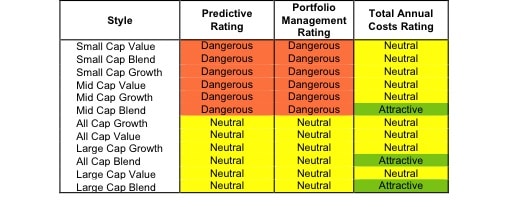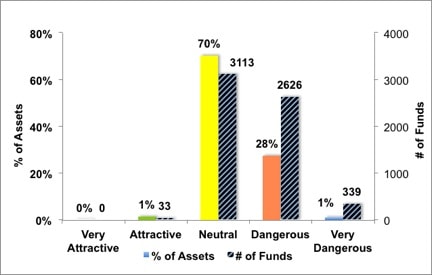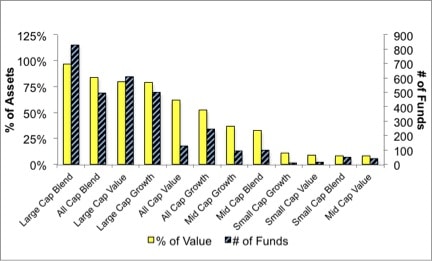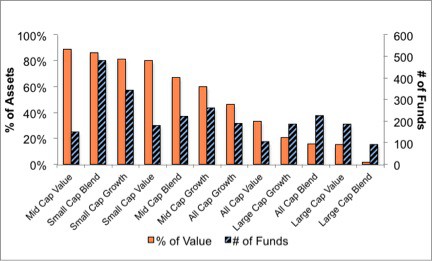No fund style earns better than a Neutral rating going into 4Q13. My style ratings are based on the aggregation of my fund ratings for every ETF and mutual fund in each style.
Investors looking for style funds that hold quality stocks should look no further than the Large Cap Blend, Large Cap Value, All Cap Blend, Large Cap Growth, All Cap Value and All Cap Growth styles. Only these styles house Attractive-or-better rated funds. Figures 6 and 7 provide details. The primary driver behind an Attractive fund rating is good portfolio management, or good stock picking, with low total annual costs.
Note that the Attractive-or-better Predictive ratings do not always correlate with Attractive-or-better total annual costs. This fact underscores that (1) low fees can dupe investors and (2) investors should invest only in funds with good stocks and low fees.
See Figures 4 through 13 for a detailed breakdown of ratings distributions by investment style. See myfree ETF & mutual fund screener for rankings, ratings and free reports on 7000+ mutual funds and 400+ ETFs.
My fund rating methodology is detailed here.
All of my reports on the best & worst ETFs and mutual funds in every sector and investment style are available here.
To earn an Attractive-or-better Predictive Rating, an ETF or mutual fund must have high-quality holdings and low costs. Only 33 style ETFs and mutual funds meet these requirements, which is only 0.5% of all style ETFs and mutual funds.
SunAmerica Focused Series, Inc: Focused Dividend Strategy Portfolio (FDSWX) is my top All Cap Value mutual fund. It gets my Attractive rating by allocating over 76% of its value to Attractive-or-better-rated stocks.
Western Union (WU) is one of my favorite stocks held by FDSWX. Western Union is currently earning a return on invested capital (ROIC) of 27%, which is in my top quintile of all companies that I cover. The company has earned positive economic earnings over the past six years. Western Union has maintained a high ROIC while also expanding its cash transfer operations into China and India. High profit margins, returns on capital and expanding market reach signal that WU is poised for strong, long-term growth.
At its current stock price of ~$18/share, the stock has a price-to-economic book value (PEBV) ratio of 0.7, which implies the market expects profits (NOPAT) to permanently decline by 30%. This expectation seems too low considering the company’s track record of consistent, steady growth.
ProFunds: Small-Cap ProFund (SLPSX) is my worst Small Cap Blend mutual fund. It gets my Very Dangerous rating by allocating over 32% of its value to Neutral-or-worse-rated stocks, and to make matters worse, charges investors annual costs of 5.61%. 40% of the fund’s asset allocation made up by cash.
Alkermes Plc (ALKS) is one of my least favorite stocks held by SLPSX. Alkermes has only earned positive after tax profits (NOPAT) in five of the last 15 years and positive economic earnings in one of the last 15 years. The company’s return on invested capital (ROIC) of 6%, below its weighted average cost of capital (WACC) of 8%, puts it in the second lowest quintile of stocks that I cover. With the stock currently trading at ~$32/share, Alkermes would have to grow profits by 20% compounded annually over the next 17 years to justify its current valuation. Such high expectations of growth seem overly optimistic given that the company has struggled to generate any profits over the last 15 years.
Figure 2 shows the distribution of our Predictive Ratings for all investment style ETFs and mutual funds.
Figure 2: Distribution of ETFs & Mutual Funds (Assets and Count) by Predictive Rating
Source: New Constructs, LLC and company filings
Figure 3 offers additional details on the quality of the investment style funds. Note that the average Total Annual Cost of Very Dangerous funds is almost 12 times that of Attractive funds.
Source: New Constructs, LLC and company filings
This table shows that only the best of the best funds get our Very Attractive Rating: they must hold good stocks AND have low costs. Investors deserve to have the best of both and we are here to give it to them.
Ratings by Investment Style
Figure 4 presents a mapping of Very Attractive funds by investment style. The chart shows the number of Very Attractive funds in each investment style and the percentage of assets in each style allocated to funds that are rated Very Attractive.
Only 4 investment style funds earn our Very Attractive rating.
Figure 4: Very Attractive ETFs & Mutual Funds by Investment Style
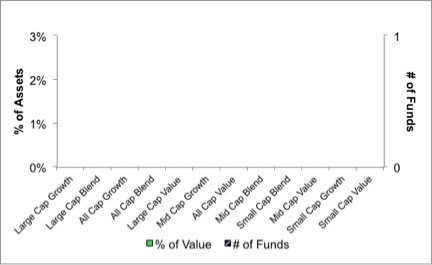 Source: New Constructs, LLC and company filings
Source: New Constructs, LLC and company filings
Figure 5 presents the data charted in Figure 4
Figure 5: Very Attractive ETFs & Mutual Funds by Investment Style
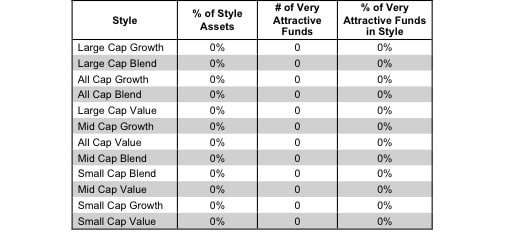 Source: New Constructs, LLC and company filings
Source: New Constructs, LLC and company filings
Figure 6 presents a mapping of Attractive funds by investment style. The chart shows the number of Attractive funds in each style and the percentage of assets allocated to Attractive-rated funds in each style.
Note that the Large Cap Value, All Cap Value, Large Cap Blend, Large Cap Growth, All Cap Growth and All Cap Blend are the only styles with Attractive-rated funds.
Figure 6: Attractive ETFs & Mutual Funds by Investment Style
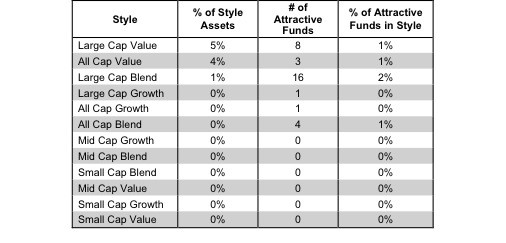 Source: New Constructs, LLC and company filings
Source: New Constructs, LLC and company filings
Figure 7 presents the data charted in Figure 6.
Figure 7: Attractive ETFs & Mutual Funds by Investment Style
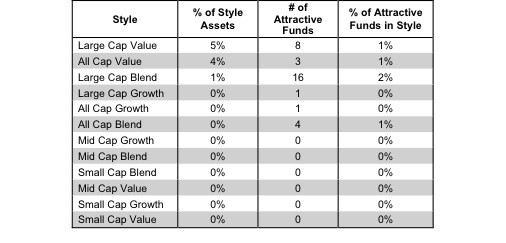 Source: New Constructs, LLC and company filings
Source: New Constructs, LLC and company filings
Figure 8 presents a mapping of Neutral funds by investment style. The chart shows the number of Neutral funds in each investment style and the percentage of assets allocated to Neutral-rated funds in each style.
Figure 8: Neutral ETFs & Mutual Funds by Investment Style
Source: New Constructs, LLC and company filings
Figure 9 presents the data charted in Figure 8.
Figure 9: Neutral ETFs & Mutual Funds by Investment Style
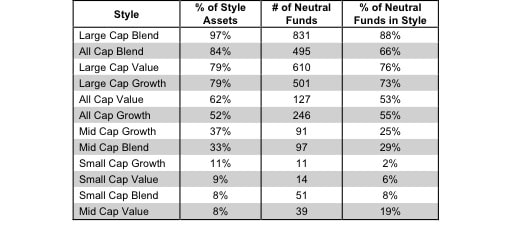 Source: New Constructs, LLC and company filings
Source: New Constructs, LLC and company filings
Figure 10 presents a mapping of Dangerous funds by fund style. The chart shows the number of Dangerous funds in each investment style and the percentage of assets allocated to Dangerous-rated funds in each style.
Six out of the twelve investment styles allocate more than half of their total net assets to Dangerous rated stocks. This means investors are disproportionately allocating to funds with poor holdings.
Figure 10: Dangerous ETFs & Mutual Funds by Investment Style
Source: New Constructs, LLC and company filings
Figure 11 presents the data charted in Figure 10.
Figure 11: Dangerous ETFs & Mutual Funds by Investment Style
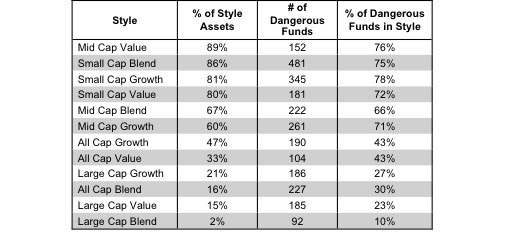 Source: New Constructs, LLC and company filings
Source: New Constructs, LLC and company filings
Figure 12 presents a mapping of Very Dangerous funds by fund style. The chart shows the number of Very Dangerous funds in each investment style and the percentage of assets in each style allocated to funds that are rated Very Dangerous.
Figure 12: Very Dangerous ETFs & Mutual Funds by Investment Style
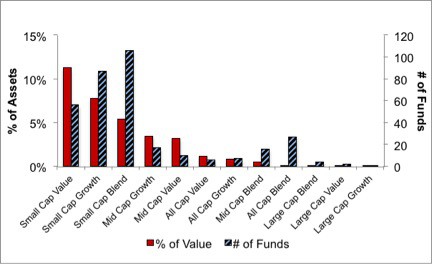 Source: New Constructs, LLC and company filings
Source: New Constructs, LLC and company filings
Figure 13 presents the data charted in Figure 12.
Figure 13: Very Dangerous ETFs & Mutual Funds by Investment Style
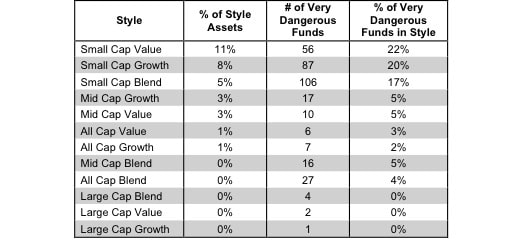 Source: New Constructs, LLC and company filings
Source: New Constructs, LLC and company filings
Jared Melnyk contributed to this report.
Disclosure: David Trainer is long WU. David Trainer and Jared Melnyk receive no compensation to write about any specific stock, sector or theme.


